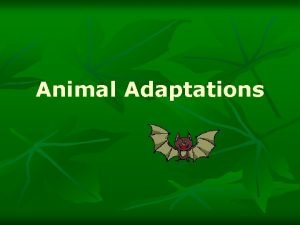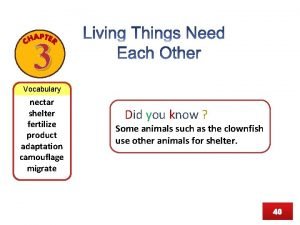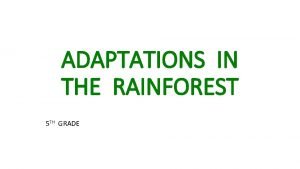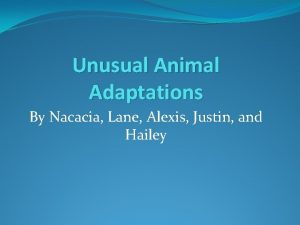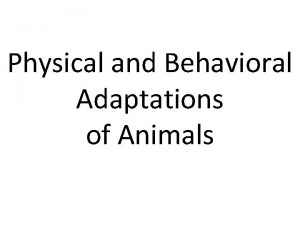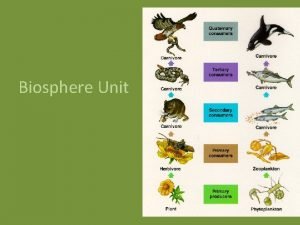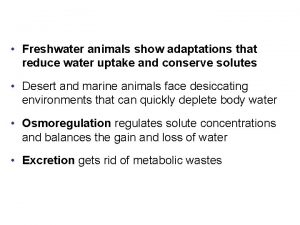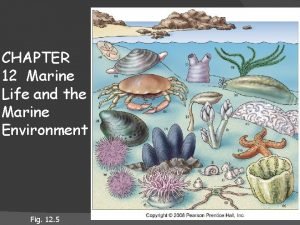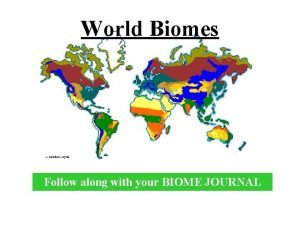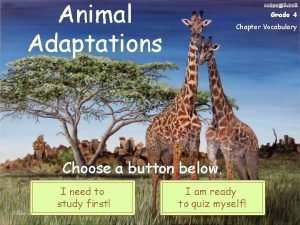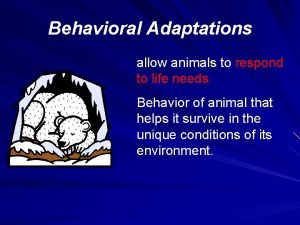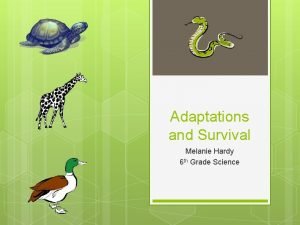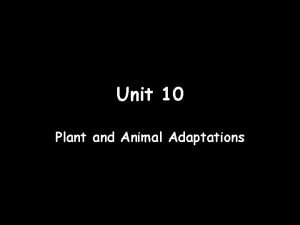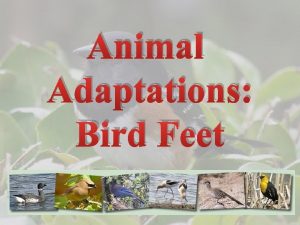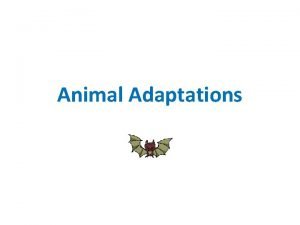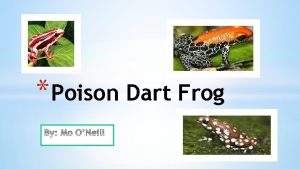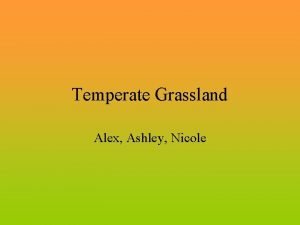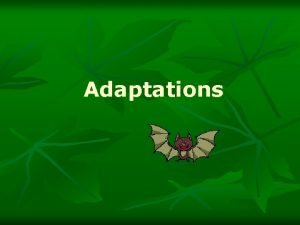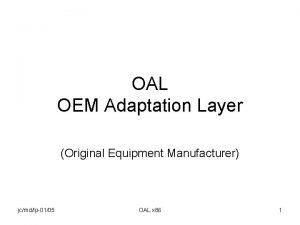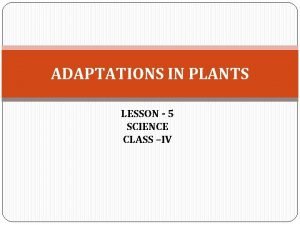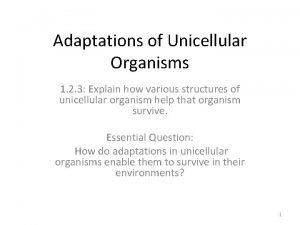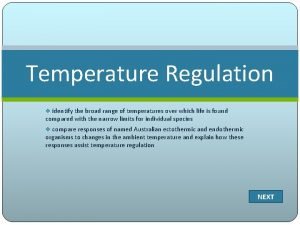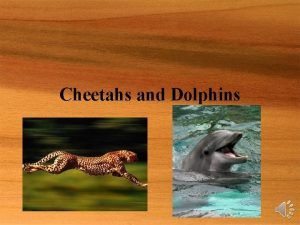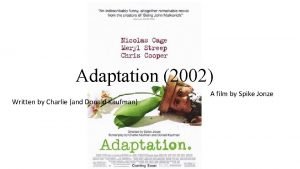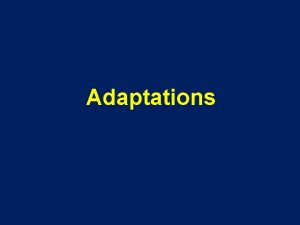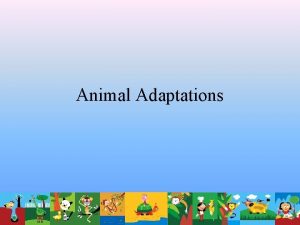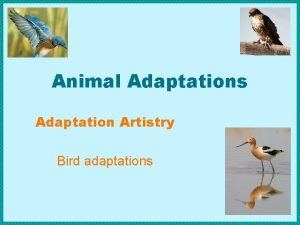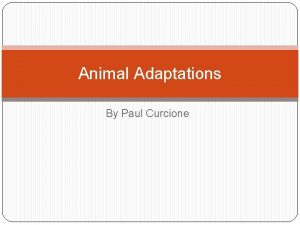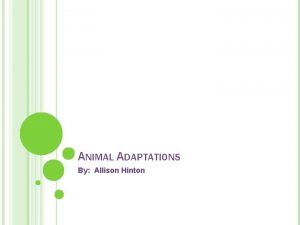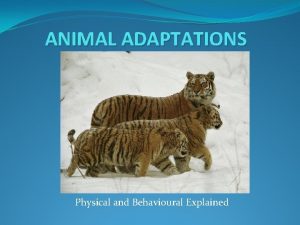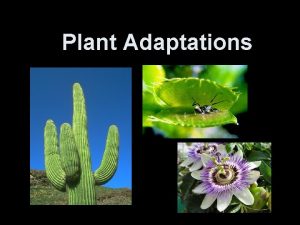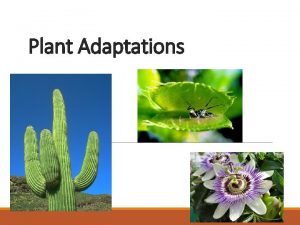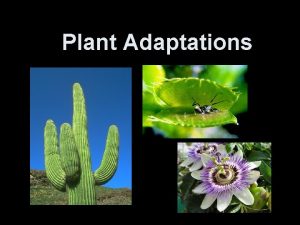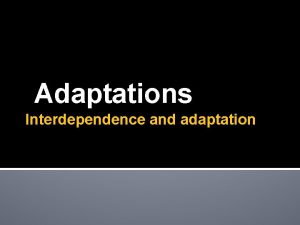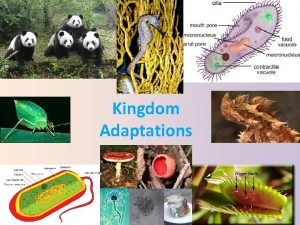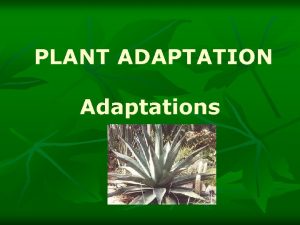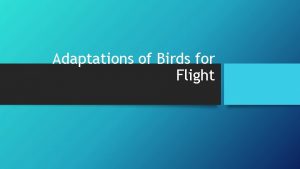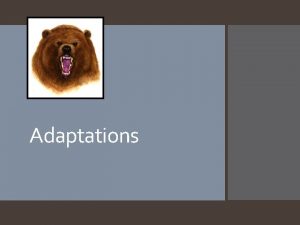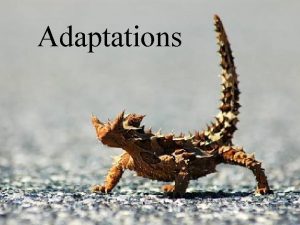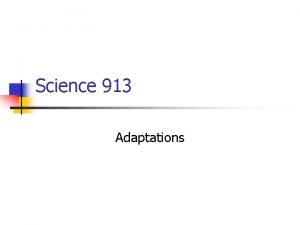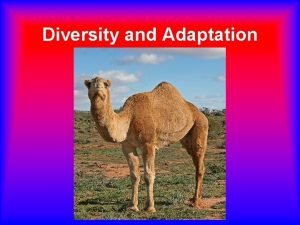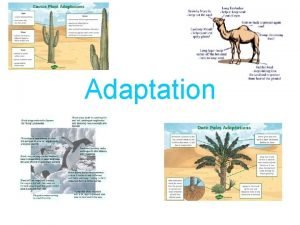Animal Adaptations WHAT ARE ADAPTATIONS An adaptation is





































- Slides: 37

Animal Adaptations

WHAT ARE ADAPTATIONS? • An adaptation is a body part (physical characteristic) or behavior that helps an organism survive in its environment. • What are some adaptations you can think of?

How is it that animals are able to survive in the wild? It is the ADAPTATIONS that animals have that help them to survive!

Think about the way you dress in the winter. You don’t wear a bathing suit when it’s snowing outside! You wear warm clothes, and maybe even a hat and gloves to protect yourself from the weather.

Please write this down on your sheet: A basic need for any animal is ability to get energy from food and survive long enough to reproduce.

Who has adaptations? ? • Herbivores: Eat only plants • Carnivores: Eat only meat • Omnivores: Eat plants and meat ALL ORGANISMS have adaptations! Organisms that are NOT ADAPTED to an environment will die out!

We can divide adaptations into two categories: ADAPTATIONS Physical AND Behavioral

Physical adaptations are body structures that allow an animal to find and eat food, defend itself/hide itself, and to reproduce its species. Hey! I’m a walking stick. I look just like a stick you’d find on the ground. Physical adaptations help an animal survive in its environment.

Physical adaptation EXAMPLE A. Camouflage: Change in color to match surroundings

Youtube: Amazing animal adaptations


More camouflage!

Physical adaptation EXAMPLE B. Mimicry : Looking or sounding like another organism (this fools predators into thinking it is another living organism that is poisonous or dangerous!) The Viceroy butterfly uses mimicry to look like the Monarch butterfly. Can you tell them apart? I’m the Viceroy! Not poisonous Poisonous I’m the Monarch!

More mimicry!

Physical adaptation EXAMPLE C. Chemical defenses: like venom, ink, sprays etc.

Physical adaptation EXAMPLE D. Body coverings & parts: claws, beaks, feet, armor plates, skulls, teeth etc.


Now let’s learn about Behavioral Adaptations…

2. Behavioral Adaptations are animals’ ACTIONS. ***Remember that Physical Adaptations are body structures.

We can divide Behavioral Adaptations into two groups: ADAPTATIONS Physical AND Behavioral Instinctive These behaviors happen naturally & don’t have to be learned. Learned These behaviors must be taught.

Instinctive behaviors EXAMPLES? : = happen naturally & don’t need to be learned

Examples of Instinctive Adaptations: Migration, Hibernation

• http: //www. vtaide. com/png/birdadaptations 3. htm • Animal Adaptation game: • http: //www. ecokids. ca/pub/eco_info/topics /climate/adaptations/index. cfm

Learned behaviors EXAMPLES? : = Gained by interacting with the environment. They cannot be passed on to the next generation except by teaching.

Examples of Learned Adaptations Learning how to hunt for food • Learning how to use tools

• Learning where to find food and water • Learning to floss teeth!

In this lesson, we have learned about ANIMAL ADAPTATIONS. There are 2 ways to describe adaptations: Physical and Behavioral

Adaptation Application: Bird beaks • Why is the beak of an eagle and a hummingbird so different? • Answer: ____________________

Adaptation Applications: Lions • Why are the eyes of a lion set in front of the head rather than on the sides?

Adaptation Applications: Lions • What is the purpose of the mane on a male lion? What is the reason for the lion’s color?

Adaptation Applications: Giraffe • How are their long necks adapted to their lifestyle?

Physical adaptations are _________. Some examples of physical adaptations are: Camouflage Mimicry Chemical defenses Body coverings & parts

• Endothermic Mammals • All have some type of “hair” – Some are very specialized, such as polar bear fur • Method of locomotion • Care for young

Birds • Leg Length – Roseate Spoonbill (top right) • Foot Webbing – Laughing Gull (top left) • Beak Shape – Long Billed Curlew (bottom)

Reptiles • Ectothermic • Scales • Some undergo hibernation and estivation • Lay eggs on land • Leg structure and position

Amphibians • Ectothermic • Lay eggs in water • Partially or fully webbed feet • Can absorb oxygen through their skin

Fish • Fins • Gills • Lateral line
 Insidan region jh
Insidan region jh Animal adaptation notes
Animal adaptation notes Http://www.blueplanetbiomes.org/world_biomes.htm
Http://www.blueplanetbiomes.org/world_biomes.htm Animal adaptations
Animal adaptations Animal adaptations for rainforest
Animal adaptations for rainforest Unusual animal adaptations
Unusual animal adaptations Animals with structural adaptations
Animals with structural adaptations Ecological pyramid tropical rainforest
Ecological pyramid tropical rainforest Adaptations of freshwater animals
Adaptations of freshwater animals Subneritic
Subneritic Grassland animals adaptations
Grassland animals adaptations Taiga adaptations
Taiga adaptations Animal adaptations grade 4
Animal adaptations grade 4 Freshwater animal adaptations
Freshwater animal adaptations Chipmunk behavioral adaptations
Chipmunk behavioral adaptations Animal adaptations webquest
Animal adaptations webquest Studyjams animal adaptations
Studyjams animal adaptations Jaguar adaptations in the tropical rainforest
Jaguar adaptations in the tropical rainforest Bird feet adaptations
Bird feet adaptations Examples of physical adaptations
Examples of physical adaptations Temperate deciduous forest animals adaptations
Temperate deciduous forest animals adaptations Poison dart frog adaptation
Poison dart frog adaptation Chaparral climatogram
Chaparral climatogram Plant adaptations in temperate grasslands
Plant adaptations in temperate grasslands Animal rights versus animal welfare
Animal rights versus animal welfare Animal cell and plant cell venn diagram
Animal cell and plant cell venn diagram Venn diagram for plant and animal cells
Venn diagram for plant and animal cells Adaptation example
Adaptation example Oem adaptation layer
Oem adaptation layer Plants for class 4
Plants for class 4 Cilia unicellular organisms
Cilia unicellular organisms What is adaptation in science
What is adaptation in science Cellular adaptation
Cellular adaptation Stress and adaptation fundamentals of nursing
Stress and adaptation fundamentals of nursing Young yun kim
Young yun kim Red kangaroo behavioural adaptations
Red kangaroo behavioural adaptations Structural adaptations of a cheetah
Structural adaptations of a cheetah Adaptation (2002
Adaptation (2002

